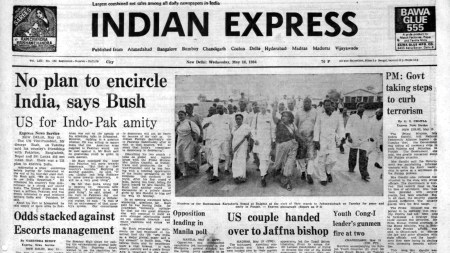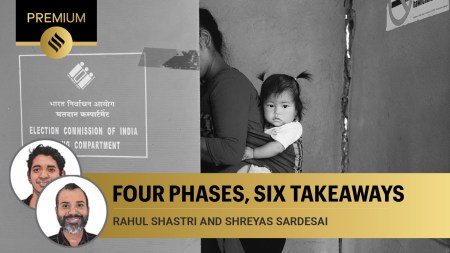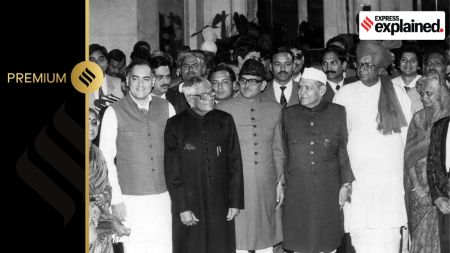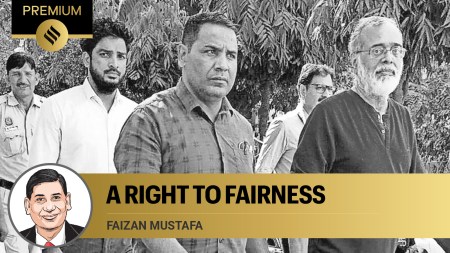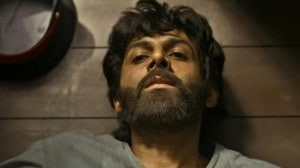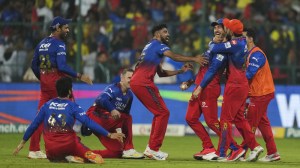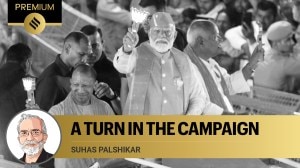- India
- International
Long arc of Telangana movement: Of struggles and stirs, history and politics, music and dance
In 2001, KCR formed TRS with the avowed objective to spearhead the Telangana statehood agitation, Prof Jayashankar became his mentor as they sought to re-energise the movement
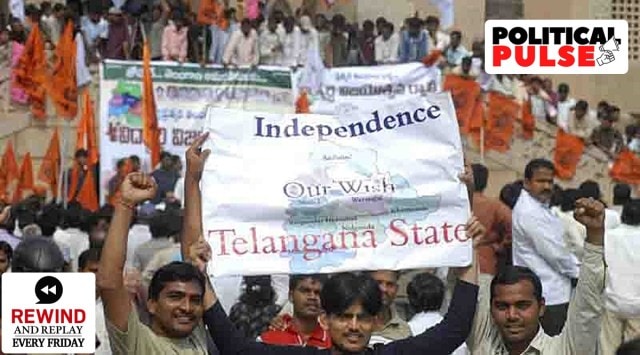 Supporters of the Telangana movement celebrate after the central government's decision to initiate the process of creating a separate Telangana state from Andhra Pradesh, at Osmania Universaity in Hyderabad. (Express archives)
Supporters of the Telangana movement celebrate after the central government's decision to initiate the process of creating a separate Telangana state from Andhra Pradesh, at Osmania Universaity in Hyderabad. (Express archives)The Telangana separate state movement, which began in early 1950, has its roots in the armed struggle waged by farmers and people of the Telangana region which had been under the Nizam-ruled Hyderabad princely state.
While India got Independence from the British in August 1947, the last Nizam held on to his Hyderabad princely state – which included nine present-day districts of Telangana, four districts of Karnataka’s Gulbarga region, and four districts of Maharashtra’s Aurangabad region – for nearly 13 more months. The last Nizam tried to maintain control over his fiefdom using his private militia called “Razakars”, which was founded in 1938 to maintain law and order but turned into a dreaded organisation under Syed Mohammed Qasim Razvi by 1947. The Razakar militia unleashed terror in the region by torturing and killing dissidents or anyone who supported them or spoke against the Nizam, indulged in large-scale rape and arson, and looting of properties.
According to Telangana residents from that period, Razvi wielded so much influence on the last Nizam that it led to the latter delaying the merger of Hyderabad princely state with the Indian Union. As Razakars clamped down on innocent families, the Telangana peasants launched an armed struggle to liberate the region from them.
Historians state that by the time the Central government launched a military operation “Operation Polo’’ in September 1948 to secure the state’s merger with India, a majority of the Telangana population felt that the region should be a separate state.
In 1952, the first elected chief minister of the erstwhile Hyderabad state, Burgula Ramakrishna Rao, faced some protests seeking proper representation of the Telagana people in his government. Similar protests were also held to press for a separate state.

In August 1953, the Centre appointed the States Reorganisation Commission (SRC) headed by Fazal Ali, Kavalam Madhava Pannikkar and H N Kunzru to examine the demands for separate states in different parts of the country.
Several people including Prof Kothapalli Jayashankar, a Telangana ideologue, and Konda Venkat Ranga Reddy, one of the leaders of the armed struggle, gave memorandums to the SRC, demanding that the region should be declared a separate state. Jayashankar and Reddy gave lengthy accounts of the social, economic, and cultural history of Telangana, as well as the natural resources and geographic justification for a separate state.
Seven years after the region was liberated from the Nizam, in September 1955, the SRC submitted its report to the Centre, recommending the formation of a separate Telangana state for five years with provision to merge it with Andhra state after the 1961 elections. As the Centre did not take any action, the Telangana people held protests for nearly a year. Politicians and elected members of Hyderabad state, including Kanada and Marathi MLAs, were divided over the issue of merger with Andhra. The Congress opposed the merger while the Communists supported it because it would have strengthened them in the combined state. Political leaders from Andhra also lobbied for the merger and in February 1956 the decision was taken to merge Telangana with Andhra Pradesh.

The leaders from both regions wrote and signed the Gentlemen’s Agreement, which provided safeguards against the exploitation of and discrimination against Telangana by the Government of Andhra Pradesh. On November 1, 1956, the Centre established the unified Andhra Pradesh – the Telugu-speaking areas were merged with Andhra Pradesh, the Marathi speaking areas with Bombay state, and Kannada speaking areas with Mysore state.
However, allegations of discrimination against Telangana by the Andhra leaders started almost immediately resulting in protests and agitations. Political leaders, intellectuals, activists and freedom fighters felt that the Telangana people faced discrimination in government jobs, education and medical facilities, public spending and civic infrastructure. Although “Mulki (locals)” rules were in place to ensure that the natives did not face problems in getting government jobs, the Telangana people felt that they were “violated” and that people from the Andhra region who migrated to Hyderabad were preferred as they became “Mulkis’’ after living there for 15 years.
The simmering anger and dissent exploded into the first major separate state agitation in January 1969. It started when a man sat on an indefinite fast at Khammam railway station demanding a separate state of Telangana. Students and civil society organisations started similar protests elsewhere and soon the protests intensified across the Telangana region. Police opened fire during incidents of arson resulting in the death of 369 students, which fuelled the agitation.
The protests also divided the then ruling Congress with several leaders coming out in support of a separate Telangana state. M Chenna Reddy first broke ranks with the Congress and along with other dissidents formed the Telangana Praja Samithi (TPS), which spearheaded the separate statehood agitation attracting mainly the youth as its support base. Although the TPS got some electoral successes, its leaders gradually gave up on the separate state demand as the then Prime Minister Indira Gandhi did not show inclination towards addressing it, especially after her party won a landslide in the March 1971 Lok Sabha elections.
The TPS eventually merged with the Congress and the stir known as the 1969 Telangana agitation ebbed away by 1973. Telangana’s intellectuals, activists, and political leaders continued to pitch for a separate state at various fora while highlighting the alleged discrimination the region and its people faced from the governments dominated by Andhra leaders. For over two decades since then, the Telangana movement remained dormant. In March 1982, the popular film actor N T Rama Rao launched the Telugu Desam Party (TDP) invoking Telugu pride, that united people during his chief ministerial tenure during 1983-1994.
Amid a multiplicity of opinions, there remains a view that the Telangana movement’s energy got channelised into the Naxalite movement, which had engulfed Telangana at that time. In 1996, Telangana activists like Akula Bhoomaiah and Belli Lalitha, who were sympathetic to the Naxalite movement, started organising themselves and launched the Telangana Jana Sabha to revive the separate state movement. Telangana Students Front and Telangana Kala Samiti were also formed at that time with the same objective. However, a government crackdown on Maoists also affected these organisations which eventually got defunct.
In the late 1990s, when the then BJP-led NDA government was considering the proposals of creation of three new states, Chattisgarh, Jharkhand, and Uttarkhand, the saffron party held its national executive meeting at Kakinada in Andhra Pradesh, where it promised to also create a separate state of Telangana if it returned to power. The BJP gave the slogan of “one vote, two states”, pledging that if the people voted for the party, then Telangana would be formed. However, the BJP dispensation did not fulfil this promise, even though it created the three new states in 2000, angering not only the Congress and TDP but also its Telangana leaders.
In April 2001, K Chandrashekar Rao, popularly known as KCR, who was with the TDP and the Deputy Speaker in the AP Assembly at that time, resigned, accusing party chief N Chandrababu Naidu of not being serious on the Telangana statehood issue.
KCR then formed the Telangana Rashtra Samiti (TRS) with the sole objective to take the Telangana statehood movement forward. Prof Jayashankar became KCR’s mentor and guide as they sought to re-energise the agitation. While folk music and arts were an integral part of Telangana society since ages, the peasant struggles, armed resistance, and the separate state movement gave a revolutionary touch to it.
Alongside the political fight for the separate state, folk artists like balladeer Gummadi Vithal Rao popularly known as Gaddar infused the agitation with soulful songs and music. He says that Telangana’s folk music made unprecedented resonance among public since 2000 as it went along with the statehood movement.
Gaddar, sensing that the movement was being “hijacked” by the TRS which he alleged had become highly political, launched the Telangana Praja Front (TPF) in October 2010, aiming to unite Dalits and backward classes and wrest control of the Telangana movement. He claimed that it was always proven that only people’s movements have succeeded and not political parties.
The Telangana agitation also made Telangana’s “Bathukamma”, a colourful and vibrant festival of flowers, very popular. It was earlier confined to villages but during the separate state protests women broke into impromtu “Bathkamma” dance. Following its formation, the TRS attracted leaders and workers from across the political and ideological spectrum. Having been denied the separate state on many occasions, both under the Congress and the NDA governments, many disgruntled Congress, BJP, Left, TDP leaders and workers joined the TRS.
While launching the TRS, KCR, in his speech, said that it did not matter to him if its new members came from the RSS or the RSU (Radical Students Union) provided that they joined it with the sole intention of fighting for the separate state of Telangana.
The TRS spearheaded the Telangana movement through protests and agitations, always highlighting the alleged injustices and discrimination towards Telangana from the AP leaders. However, with its electoral fortunes fluctuating it could not then put adequate pressure on the Centre.
Nearly nine years after the launch of the TRS, as protests engulfed educational institutions in the Telangana region, some students started dying by suicide demanding a separate state. While KCR and other TRS leaders appealed to the students not to take the extreme step, the suicide incidents kept happening with the region turning into a tinderbox.
On November 29, 2009, KCR started an indefinite fast demanding that the then Congress-led UPA government immediately table the Telangana statehood bill in Parliament. On December 9 evening, the then Union home Minister P Chidambaram issued a statement stating that the process of creation of Telangana state had been set in motion. Amid the celebrations the TRS softened up even as the Centre kept dragging its feet. The agitation changed hands, with the formation of the Telangana Joint Action Committee (TJAC) headed by Prof M Kodandaram, a professor of political science at Osmania University, who stepped in when the TRS initially failed to capitalise on the Centre’s December 2009 announcement.
The TJAC turned the agitation on its head, scaling up the protests, laying siege to Hyderabad, and using tactics to bring the government to a halt and keeping it on the edge. Under Kodandaram’s guidance, the students of all ages in education institutions united into a major force with Osmania University as the nerve centre of the stir. The unions and associations of teachers, doctors, lawyers, government employees, farmers, NGOs, civil society organisations, poets, and pro-Telangana groups joined a common platform for the cause under the TJAC, which subsequently launched protests like the “Million March’’, non-cooperation by Telangana employees, student agitations in colleges and universities, creation of district Joint Action Committees, and laying siege to the Assembly.
The TJAC kept the pot boiling by taking out rallies without government permission, even as students and protesters fought pitched battles with police and security forces. What proved to be a turning point in the statehood struggle was the launch of the Sakala Janula Samme (all peoples’ strike) campaign on September 24, 2011 for 42 days, during which everything came to a halt in Telangana including transport and other public services. All the highways in the region were blocked and railway tracks were jammed at several places. People left their homes and camped and cooked and slept on the roads.
The “Million March” which was organised three times – on March 10, 2011, September 27, 2011 and June 19, 2013 – by the TJAC with support from the TRS, brought lakhs of protesters to Hyderabad. The Telangana employees struck work for nearly two months forgoing their salaries. More than 50,000 workers of the Singarenni Collieries did not go to work for 45 days in spite of repeated threats of pay cuts.
The Justice B N Srikrishna Committee, which was constituted to look into the separate Telangana state demand, submitted its report to the Centre in December 2010. In its recommendations, the panel gave six options: 1) Maintaining status quo – keeping Andhra Pradesh state as it is without any change in the Telangana, Rayalaseema and Coastal Andhra regions; 2) bifurcating Andhra Pradesh into Seemandhra and Telangana regions with both of them developing their own capitals in due course of time, with Hyderabad as a Union Territory; 3) dividing Andhra Pradesh into two states – one of Rayala-Telangana with Hyderabad as its capital and second one of Coastal Andhra Pradesh; 4) dividing Andhra Pradesh into Seemandhra and Telangana with enlarged Hyderabad Metropolis as a separate UT; 5) bifurcation of the state into Telangana and Seemandhrâ as per existing boundaries with Hyderabad as the capital of Telangana and a new capital for Seemandhra; and 6) keeping the state united and providing for creation of a statutorily empowered Telangana Regional Council for socio-economic development and political development of Telangana region.
All these options suggested by the Committee were rejected by the Telangana leaders who demanded a separate Telangana state comprising 10 districts.
Finally, after five more years of protests since Chidambaram’s December 2009 announcement, the UPA government eventually tabled the AP Reorganisation Bill, 2014 in the Lok Sabha on February 18, 2014 and on February 20 in the Rajya Sabha, passing it to carve the separate state of Telangana out of Andhra Pradesh.
May 18: Latest News
- 01
- 02
- 03
- 04
- 05



